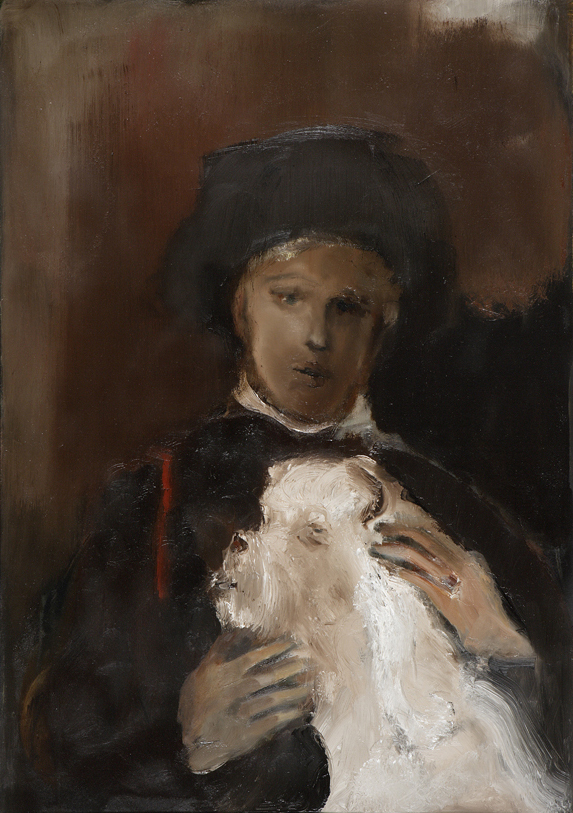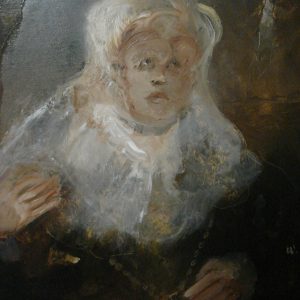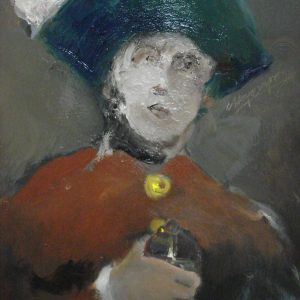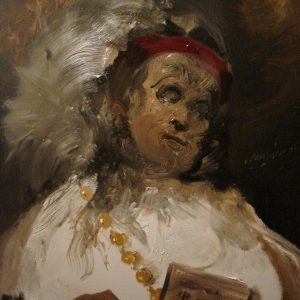Description
Artist/Maker: Kostas Kampouropoulos (1939-2018)
Object/Materials and Techniques: Oil On Canvas
Date: Painted between 2007-2016
Dimensions: H. 100 cm. x W. 70 cm.
Art style: Portraiture / Romantic VIsionism / Abstract Expressionism / Minimalism
Current Location: Private collection
Curator’s note: Here is an imaginary portrait of attractive depiction of a boy that cuddles a female Molossus dog, drawing up via Kostas Kampouropoulos characteristic features of his very personal vernacular regarding colour selectivity, lack of outlines and vague conception.
Softly abstracted forms and colour gradations aspire to emulate softness and provoke contemplation. The viewer experiences the artist’s characteristic style of gentle colour scheme and delicately brushed contours, through which he succeeds in evoking out of the portrayed intimate scene sound emotional effect.
The technique of fuzzy outline and the absence of crisp lines that strongly describe not only the artist’s present oeuvre but also his total output constitutes a practice widely used in Romanticism, the art movement -late 18th and early 19thcentury- of which Kostas Kampouropoulos was influenced the most throughout his career. More specifically, alike the portraits of Romanticism, forward and beyond mere pictorial representation of the subject, the portraits of Kostas Kampouropoulos, past the obvious, perceive the inner soul, the emotions and the personality of the portrayed character.
As so, in the present painting, through his romanticistic style, adapted in a very personal and modern edition, Kostas Kampouropoulos dives into the emotional bondage between a youth and his dog. The boy’s face and its expressions unfold the strong relationship between them. The young man seems as though he is confident about himself, his aristocratic origin and the dog’s faithfulness towards him, drawing the viewer’s absolute attention.
The dark earthly colouration in combination with various versions of ‘Van Dyck coffee’ -the artist’s favourite palette- within an overall vague atmosphere, succeeds in conveying a sense of poetic sombre aura while adding to the introspection of the portrayed boy. The preferred moody hued colour palette is masterfully contrasted with the white pattern of the dog figure. On this wise, a playful changeover between dusky shapes and lighting proves the assurance of a high calibre artist who disciplines the intensity of colour, granting the work, a visual beauty. Accordingly, the whole composition is orchestrated through a dark and shadowy composition that surrounds and brings into focus the central hugging pose.
As well, interconnected emotions create reflective connotations for the viewer who becomes involved with the emotional tense of the dominant character, particularly when sharing the same love for dogs. Likely taken from memories and realities of his life and his own special affection for dogs, the artist offers thought-provoking starting points, drawing attention upon the intensity in personal moments.
As he points out in his book For the Painting (2013): ‘I love animals very much and I admire them; the love and frequent invocation of animals by me was the reason to be given, mainly by a friend, the nickname ‘The Dog’. Actually, it does not sound bad to me. Besides, I feel like a medieval lord of Verona.’
At the same time, of great importance is the artist’s characteristic intension to demonstrate the clothing of the era he refers to which, in the case herein, recalls the 17th-century noble suit of Thomas Gainsborough best known portrait painting, The Blue Boy, a work that, in general, inspired Kostas Kampouropoulos specific canvas.
Curator’s highlight detail: Kostas Kampouropoulos characteristic use of sienna (reddish hue) on boy’s noble attire grants the painting a distinct classical splendour.
Notation:
- Thomas Gainsborough RSA FRSA (1727-1788) is a British portrait and landscape painter, one of the most important of the second half of the 18tth century. Along with Richard Wilson were credited as originators of the 18th-century British landscape school. He was a founding member of the Royal Academy, and was honourably awarded with the Fellowship of the Royal Society for the Encouragement of Arts, Manufactures and Commerce (FRSA), a prize-honour granted to individuals that the Royal Society of Arts (RSA) judges to have made outstanding achievements to social progress and development.
- Lords of Verona, Cangrande II Scaligeri (Big Dog) (1351–59) a cruel and suspicious tyrant, and Cansignorio Scaligeri (Master Dog) (1359–75).
The Della Scala family whose members were known as Scaligeri (Italian) or Scaligers (from the Latinized de Scalis) was the ruling family (not so well-liked) of Verona and mainland Veneto (except for Venice) from 1262 to 1387, for a total of 125 years.
The statue of the first, on horseback in a combat uniform (carrying helmet with wings), rises near Castel Vecchio. The statue of the second, less majestic but also more artful than the first, adorns the historic town square.





